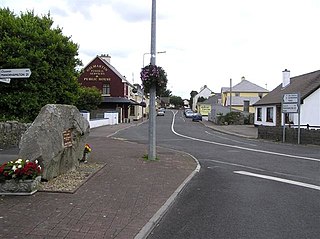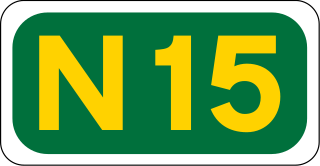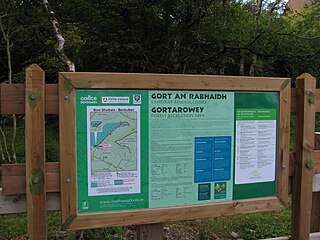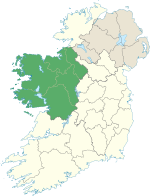
County Sligo is a county in Ireland. It is in the Northern and Western Region and is part of the province of Connacht. Sligo is the administrative capital and largest town in the county. Sligo County Council is the local authority for the county. The population of the county was 70,198 at the 2022 census. It is noted for Benbulben Mountain, one of Ireland's most distinctive natural landmarks.

Drumcliff or Drumcliffe is a village in County Sligo, Ireland. It is 8 km (5 mi) north of Sligo town on the N15 road on a low gravel ridge between the mountain of Ben Bulben and Drumcliff Bay. It is on the Drumcliff River, originally called the "Codnach", which drains Glencar Lake. Drumcliff is the resting place of the Irish poet W. B. Yeats. Drumcliff is in a civil parish of the same name.

Kinlough is a large village in north County Leitrim. It lies between the Dartry Mountains and the Atlantic Ocean, and between the River Duff and the River Drowes, at the head of Lough Melvin. It borders County Donegal and County Fermanagh, both in Ulster, and is near Yeats Country in County Sligo. It lies 2.5 miles from Bundoran in County Donegal, and across Lough Melvin from the village of Garrison in County Fermanagh.

The N15 road is a national primary road in the north-west of Ireland. It runs from Sligo to Lifford, County Donegal. It forms part of the proposed Atlantic Corridor route. It also goes to the border with Northern Ireland.

Cuilcagh is a mountain on the border between County Fermanagh and County Cavan. With a height of 666 metres (2,185 ft) it is the highest point in both counties. It is also the 170th highest peak on the island of Ireland, and Ireland's only cross-border county top. Water from the southern slope flows underground until it emerges some miles away in the Shannon Pot, the traditional source of the River Shannon. The area is sometimes referred to as the Cuilcagh Mountains.

The Dartry Mountains are a mountain range in the north west of Ireland, in the north of counties Sligo and Leitrim. They lie between Lough Melvin, Lough Gill and Lough MacNean. The highest point is Truskmore at 647 metres (2,123 ft). Other notable mountains include Benbulbin at 526 metres (1,726 ft), Benwiskin at 514 metres (1,686 ft), and Tievebaun at 611 metres (2,005 ft).
"Under Ben Bulben" is a poem written by Irish poet W. B. Yeats.
Hanging Rock is a large limestone cliff with an obtuse angle. It is located beside the village of Florencecourt in County Fermanagh, Northern Ireland, and is part of the Cuilcagh mountain region. The cliff is situated in an area dedicated The Hanging Rock Nature Reserve, which is in turn part of the Marble Arch Caves Global Geopark.

Ballaghnatrillick, locally Ballintrillick, is a village in County Sligo, Ireland.

The River Duff, or Bunduff, is a river in County Sligo and County Leitrim, Ireland. The River Duff is 14 miles (23 km) long, flowing from Glenade Valley in County Leitrim to the sea. In County Leitrim it is also known as the Black River. It is joined by the Ballanaghtrillick River, which runs out of the Horseshoe Pass.
The Caves of the Tullybrack and Belmore hills are a collection of caves in southwest County Fermanagh, Northern Ireland. The region is also described as the West Fermanagh Scarplands by environmental agencies and shares many similar karst features with the nearby Marble Arch Caves Global Geopark.

The Cuilcagh Lakelands Geopark formerly known as the Marble Arch Caves Global Geopark straddles the border between Northern Ireland and the Republic of Ireland. It is centred on the Marble Arch Caves and in 2001 it became one of the first geoparks to be designated in Europe.

The Cliffs of Magho are a 9-kilometre-long (5.6 mi) limestone escarpment located in the townland of Magho, County Fermanagh, Northern Ireland. The NNW-facing cliffs overlook the western reaches of Lower Lough Erne and define the northern edge of Lough Navar Forest, a major plantation managed by the Forest Service of Northern Ireland. A popular viewpoint atop the cliffs is accessed by a forest drive.

The Border Region is a NUTS Level III statistical region of Ireland. The name of the region refers to its location along the Republic of Ireland–United Kingdom border. It is not a cross-border region. It comprises the Irish counties of Cavan, Donegal, Leitrim, Monaghan and Sligo. The Border Region spans 11,516 km2, 16.4% of the total area of the state, and has a population of 419,473 persons as of the 2022 census, 8.14% of the state total.

Gortarowey Forest Recreation Area is a forest park and recreation area at the foot of Ben Bulben near Drumcliffe in County Sligo, Ireland. The park is currently managed by Coillte, Ireland's commercial forestry company, as part of the larger Benbulben Forest. The park lies adjacent to the Benbulben, Gleniff and Glenade Special Area of Conservation and is known as the only area in Ireland where chickweed willowherb and alpine saxifrage can be found.
Gortnaleck Court Tomb is a court cairn and National Monument located in County Sligo, Ireland.
The Tyrone Group is a lithostratigraphical term coined to refer to a particular succession of rock strata which occur in Northern Ireland within the Visean Stage of the Carboniferous Period. It comprises a series of limestones, shales and sandstones which accumulated to a thickness of 2400m in the northwest Carboniferous basin of Ireland. The type areas for the group are the Clogher Valley of County Tyrone and the Fermanagh Highlands of nearby County Fermanagh. The rocks of the group sit unconformably on older rocks of the Shanmullagh Formation of the Fintona Group which are the local representatives of the Lower Old Red Sandstone. The top of the Dartry Limestone, the uppermost part of the group, is a disconformity, above which are the layered sandstones and shales of the Meenymore Formation of the Leitrim Group. The succession continues south and west across the border into the Republic of Ireland, though different names are typically applied.
The Leitrim Group is a lithostratigraphical term coined to refer to the succession of rock strata which occur in Northern Ireland within the Visean and Namurian stages of the Carboniferous Period. The group disconformably overlies the Dartry Limestone of the Tyrone Group.
Drumcliff Monastery was located in Cairbre Drom Cliabh, now County Sligo, five miles north of the modern town of Sligo. The site consists of the remains of a round tower and several high crosses, including one outstanding example. It is currently also the site of a Church of Ireland parish church and a graveyard. It is the burial place of the poet William Butler Yeats. Founded in the 6th century by Saint Colmcille, he is said to have declared in a later literary fragment:
Beloved to my heart also in the West— Drumcliffe at Culcinne's strand.

The Mullaghmore Peninsula, also referred to as Mullaghmore Head, is a small peninsula in the north of County Sligo, Ireland. The coastal village of Mullaghmore is the peninsula's sole settlement. The village has 136 year-round residents according to the 2016 Census; however, its population is significantly higher during summer months. The peninsula is bounded by two large beaches on either side, and sports panoramic views of Ben Bulben and the Dartry Mountains, making it one of Sligo's most popular seaside destinations.






















